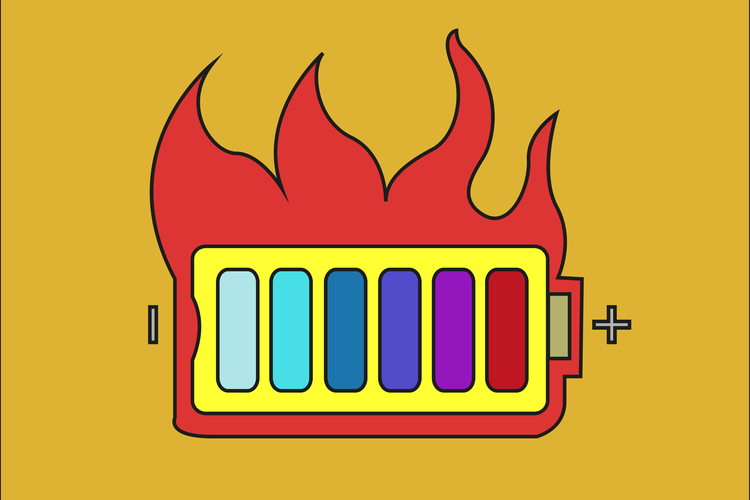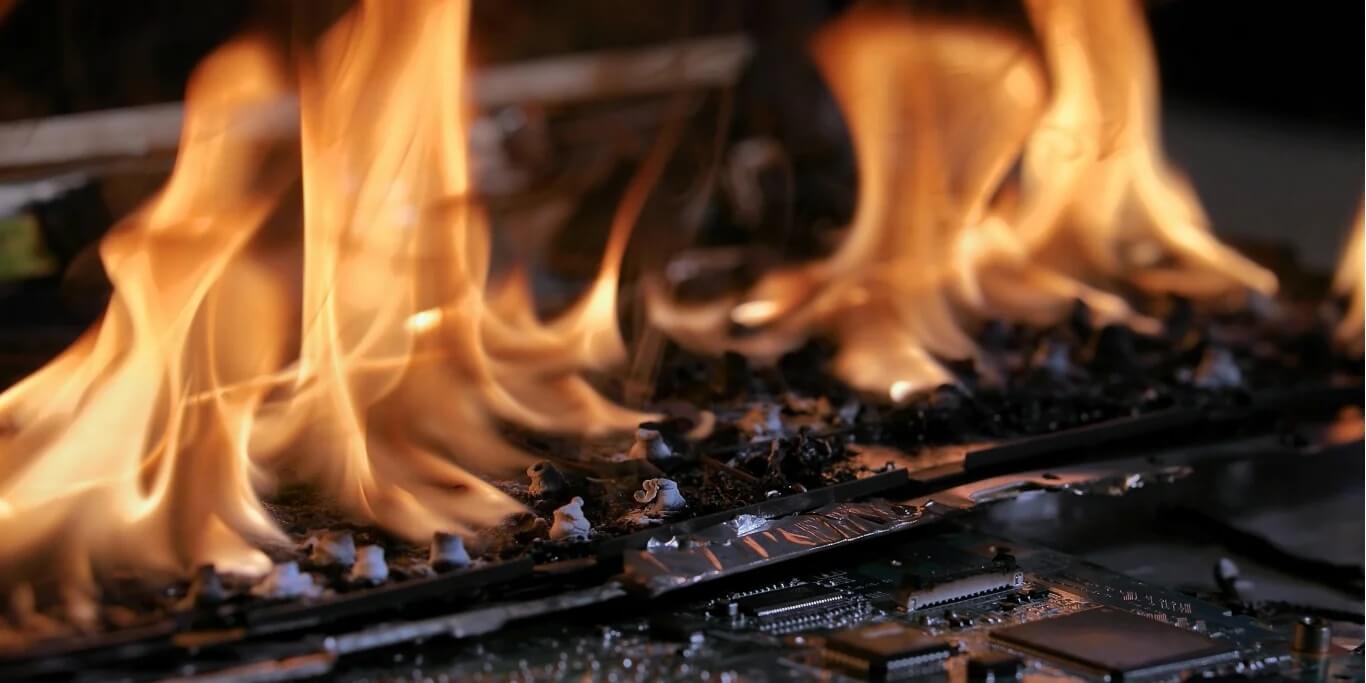Lithium-ion (or Li-ion) batteries are generally safe to use, but with increasing numbers of people and businesses depending on them, accidents are more likely to happen. Years after the Samsung Galaxy 7 recall, problems with exploding phones, e-cigarettes, and laptops persist. Between 2006 and 2021, a total of 340 occurrences involving smoke or burning lithium-ion batteries were reported to the Federal Aviation Administration (FAA) by the aviation industry.
Companies and workers that use products and gadgets powered by Li-ion batteries often should be aware of the risks involved and follow some basic standards for handling and storing the batteries to prevent fires and injuries in the workplace.
To make sure your workers are prepared and equipped to avoid lithium-ion battery fires from occuring in the workplace, let's talk about how they start, which fire extinguisher to use, and valuable lithium-ion battery safety advice.
The risk of thermal runaway is a major contributor to the failure or ignition of lithium-ion batteries. When the battery gets too hot, a chain reaction starts inside of it, which might trigger a fire. Furthermore, thermal runaway can occur if a battery is subjected to abusive conditions like high temperatures, physical abuse, or incorrect charging.

The organic electrolyte in a battery is vaporised and the cell case is pressurised during thermal runaway, two effects of the chain reaction. Batteries contain combustible and poisonous gases that can be released if their protective casing breaks. This raises even more issues. For instance, once thermal runaway has begun, the process can no longer be halted. You can't even turn it off by removing the battery. It's also possible that this runaway reaction has been going on for some time before you even noticed it. As a result, you need to make sure the battery is exposed and charging in a location apart from anything that could catch fire.
The spread of cell failure is what we're trying to control. Some LIB technologies ignite upon failure, while others release their gas rather than ignite, creating a potentially explosive mixture of gases like hydrogen. So, unfortunately, thermal runaway leads to either a fire or the release of gases. Attempts to mitigate either the fire or explosive hazard can have unintended consequences for the other.
Is it reasonable to be concerned that your phone or computer will catch fire for no apparent reason? Don't fret; the likelihood of that happening is low.
The failure of a lithium-ion battery can fall into one of two categories. The first is a problem with the battery's construction; when this happens, a recall of Li-ion batteries is commonplace. The Samsung Galaxy Note7, for instance, was recalled twice for battery problems before being taken off the market permanently.
Battery failure of the second category is more elusive to diagnose. Stress events like vibration or an electrical short, or even random chance, are generally to blame. According to the Battery University:
“A mild short will only cause elevated self-discharge and the heat buildup is minimal because the discharging power is very low. If enough microscopic metallic particles converge on one spot, a sizable current begins to flow between the electrodes of the cell, and the spot heats up and weakens. As a small water leak in a faulty hydro dam can develop into a torrent and take a structure down, so too can heat buildup damage the insulation layer in a cell and cause an electrical short. The temperature can quickly reach 500°C (932°F), at which point the cell catches fire or it explodes.”

Consumer-grade lithium-ion batteries share no chemical properties with lithium metal despite sharing their name. Thus, a Class D fire extinguisher should not be used on a fire involving a lithium-ion battery. Dry powder fire extinguishers of the Class D variety are designed for use solely on flames involving flammable metals. Due to the lack of metallic lithium in their construction, lithium-ion batteries cannot be put out with a Class D dry powder extinguisher.
How, therefore, does one go about selecting an appropriate fire extinguisher? Class B fires caused by lithium-ion batteries can be put out with any conventional ABC or dry chemical fire extinguisher. Liquids that can catch fire fall within Class B. Class B fire rating is given because of the conductive channel provided by the liquid electrolytes in lithium-ion batteries.
In the event of a lithium-ion (Li-ion) battery failure, such as a fire or explosion, it is important to manage the risks in a comprehensive manner. Use a fire suppression system engineered for this purpose if possible. Keep in mind that even if only one battery cell catches fire, the fire could spread to the rest of the battery and cause an explosion. Gas detection and exhaust systems are both code necessities and practical precautions that should be taken. In order to effectively manage a fire or explosion caused by a lithium-ion battery, you need to use a fire and explosion system made specifically for these types of accidents.
Cellphones, notebooks, EVs, power tools, and even some stationary power plants employ lithium-ion batteries as part of their Energy Storage Systems. These batteries may be compact, but they provide a mighty punch. While these batteries are normally risk-free and dependable, they can catch fire under specific circumstances.
Overstressing a lithium-ion battery can cause it to fail, which can then lead to Thermal Runaway and, in extreme cases, a fire or explosion. Puncturing or crushing a battery causes it to become unstable and can cause it to catch fire. Dropping or otherwise impacting a gadget with a lithium-ion battery can cause this.
Lithium-ion batteries frequently catch fire when subjected to extreme heat. The optimal operating temperature for these batteries is specified by the manufacturer. Overheating can cause instability, thermal runaway, the release of explosive gases, or even an outright fire. This can occur if the device is not stored properly or if the appropriate environmental temperature ranges are not maintained, such as in the case of a failed HVAC system that causes an overheated room.
Charging a lithium-ion battery incorrectly is another common cause of battery failure. A Battery Management system, like the one in your phone, but on a far grander scale, manages the charging process. A battery can become unstable and trigger Thermal Runaway if it is charged with an unsuitable charger or a damaged or malfunctioning charger.
Metallic lithium can form inside a battery if it is overcharged or charged at a high current. When the plated-out lithium finally forms short circuits between internal battery components, for example, this can be exceedingly dangerous because metallic lithium is highly reactive and can spark a fire if it comes into touch with other elements within the battery.
In general, lithium-ion batteries must be treated with care to prevent damage from being caused by rough handling, extreme temperatures, or incorrect charging. There is considerable worry that even when they are not being used, these batteries may burst into flame or release explosive gases.
.jpg)
If your lithium-Ion or lithium metal battery catches fire, please refer to the following guidelines:
lIn the event of a fire, water can be used to extinguish lithium-ion batteries because they only contain trace amounts of the metal. However, a Class D fire extinguisher is needed for lithium-metal batteries.
lLithium is affected by water. If a lithium-metal fire breaks out and you don't have access to a Class D extinguisher, you can put it out by pouring water on it.
lFoam extinguishers, carbon dioxide, ABC dry chemicals, powdered graphite, copper powder, and soda (sodium carbonate) are all effective ways to put out a fire involving lithium ions. Only use Class D extinguishers on fires involving lithium metal.
lIf a lithium-ion battery fire cannot be put out, let the pack burn in a safe and controlled environment.
lKeep in mind that each cell may be consumed at its own pace when heated, therefore it's important to monitor cell growth. Exposed a pack that appeared to have been burned for some time.
lIf the lithium battery causes a fire, you must use the proper extinguishing chemical to put out the flames. The correct extinguishing agent must be used for each different kind of fire.
lOnly those who are properly trained and equipped should attempt to put out a fire caused by a lithium-metal or lithium-ion battery.
Injuries caused by lithium-ion batteries in the workplace are avoidable if workers are kept informed. To help businesses and their employees avoid fires and injuries in the workplace, here are some safety precautions for handling lithium-ion batteries.
lNever dispose of batteries without first checking local, state, and federal guidelines.
lSmall battery fires should be put out according to the manufacturer's instructions.
lUse just the battery that came with your gadget.
lNever attempt to charge your smartphone without the original cable.
lBatteries should be stored in their original containers.
lBatteries should be stored at normal temperature.
lKeep batteries out of heated environments like automobiles or the sun.
lKeep batteries in a cool, dry place with good air circulation.
lPut batteries and electronics in a fireproof safe.
lWhen the batteries are fully charged, remove them from the charger.
lDo not place a device to be charged under cushions or on furniture.
lUse only products that have been certified as safe by an independent testing facility.
lBatteries and chargers for replacements should be compatible and purchased from the same source.
lAvoid stacking battery boxes unevenly, as this poses a tipping hazard.
lBattery life and any damage should be checked before usage. If there are flaws, they should not be used and should be stored far from anything that could catch fire.
lTake the device apart right away if the battery starts to get hot or exhibits signs of damage.

扫码关注
We use cookies to understand how our audience uses our site.
Renon Power websites use cookies to deliver and improve the website experience. See our cookie policy for further details on how we use cookies. Privacy Policy